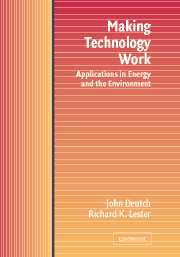Book contents
- Frontmatter
- Contents
- Preface
- 1 Introduction
- 2 Gasohol
- 3 Solar Thermal, Windpower, and Photovoltaic Technologies
- 4 Electricity from Coal
- 5 Controlling Acid Rain from Coal-fired Power Plants
- 6 Greenhouse Gases and Global Warming
- 7 Nuclear Power and Its Fuel Cycle
- 8 Managing Nuclear Waste
- 9 Nuclear Power and Weapons Proliferation
- 10 Natural Gas
- 11 Safety and Risk: Examples from the Liquefied Natural Gas and Nuclear Industries
- 12 Synthetic Fuels
- 13 Fuel Cells For Automobiles
- 14 Energy Models and Statistics
- 15 The Government's Role in Innovation
- 16 Conclusions
- Index
11 - Safety and Risk: Examples from the Liquefied Natural Gas and Nuclear Industries
Published online by Cambridge University Press: 10 December 2009
- Frontmatter
- Contents
- Preface
- 1 Introduction
- 2 Gasohol
- 3 Solar Thermal, Windpower, and Photovoltaic Technologies
- 4 Electricity from Coal
- 5 Controlling Acid Rain from Coal-fired Power Plants
- 6 Greenhouse Gases and Global Warming
- 7 Nuclear Power and Its Fuel Cycle
- 8 Managing Nuclear Waste
- 9 Nuclear Power and Weapons Proliferation
- 10 Natural Gas
- 11 Safety and Risk: Examples from the Liquefied Natural Gas and Nuclear Industries
- 12 Synthetic Fuels
- 13 Fuel Cells For Automobiles
- 14 Energy Models and Statistics
- 15 The Government's Role in Innovation
- 16 Conclusions
- Index
Summary
The application of almost all new technologies involves some degree of risk to public health and safety and the environment, and these risks must be systematically considered. For some technologies the risks are primarily confined to the manufacturing process. In other cases, it is the users who incur the main risks. In still other cases, the risks are externalized – that is, they are borne by people who are not direct beneficiaries of the technology either as suppliers or users. Where the new technology is displacing an existing product or process, the net risk to society may be either increased or reduced. A few technologies have the potential to cause harm on a large scale as a result of a single event. The probability of such events may be extremely low, but they cannot be ruled out entirely. Special methods have been developed to evaluate these low-probability, high-consequence risks. This chapter briefly introduces these methods, using nuclear power plants and liquefied natural gas facilities as examples. We also consider the question of public attitudes toward health and safety risks. Innovators and safety regulators alike need to understand how the public perceives risks, how these perceptions are formed, and what causes them to change.
LIQUEFIED NATURAL GAS
There are many areas of the world where gas exists in great abundance, either in free deposits, for example, in New Zealand, Indonesia, and Algeria, or associated with oil reserves, for example, in Nigeria and Saudi Arabia.
- Type
- Chapter
- Information
- Making Technology WorkApplications in Energy and the Environment, pp. 181 - 193Publisher: Cambridge University PressPrint publication year: 2003

